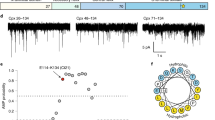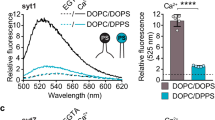Abstract
THE seven botulinum neurotoxin (NT) serotypes produced by strains of Clostridium botulinum inhibit neurotransmitter release from synaptic vesicles. Neurotoxin is synthesized as a roughly 150K single-chain protein. Proteolysis produces two fragments, the 50K L-chain and 100K H-chain, that remain linked by a disulphide bond. Intoxication involves membrane attachment by the C-terminal half of the H-chain, endocytotic/lysosomal internalization, vesicle channel formation mediated by the 50K N-terminal half of the H-chain at low pH, and finally blockade of synaptic vesicle fusion after the L-chain reaches the cytosol1–4. We report here the visualization of the neurotoxin–membrane complex by electron cryomicroscopy and image processing. Three-dimensional reconstructions show the neurotoxin bound to the exterior of ganglioside/PC lipid vesicles and show channels entirely perforating the vesicle wall. Each channel appears to arise from the interaction of four neurotoxin molecules.
This is a preview of subscription content, access via your institution
Access options
Subscribe to this journal
Receive 51 print issues and online access
$199.00 per year
only $3.90 per issue
Buy this article
- Purchase on Springer Link
- Instant access to full article PDF
Prices may be subject to local taxes which are calculated during checkout
Similar content being viewed by others
References
Simpson, L. L. (ed.) Botulinum Neurotoxin and Tetanus Toxin (Academic, San Diego, 1989).
DasGupta, B. R. J. Physiol., Paris 84, 220–228 (1990).
Dolly, J. O. et al. J. Physiol., Paris 84, 237–246 (1990).
Simpson, L. L. A. Rev. Pharmacol. Toxicol. 26, 427–453 (1986).
Robinson, J. P., Schmid, M. F., Morgan, D. G. & Chiu, W. J. molec. Biol. 200, 367–375 (1988).
Kornberg, R. D. & Darst, S. A. Curr. Opin. Struct. Biol. 1, 632–646 (1991).
Chang, C. F. et al. J. Ultrastruct. molec. Struct. Res. 100, 166–172 (1988).
Schmid, M. F., DasGupta, B. R. & Robinson, J. P. Proc. XII Int. Congr. Electron Microscopy, Seattle, 1990, 496–497 (San Francisco, 1990).
Hoch, D. H. & Finkelstein, A. Ann. NY. Acad. Sci. 456, 33–35 (1985).
Donovan, J. J. & Middlebrook, J. L. Biochemistry 25, 2872–2876 (1986).
Montal, M. S. et al. FEBS Lett. 313, 12–18 (1992).
Binz, T. et al. J. biol. Chem. 265, 9153–9158 (1990).
Hoch, D. H. et al. Proc. natn. Acad. Sci. U.S.A. 82, 1692–1696 (1985).
Schmid, M. F. et al. J. molec. Biol. 221, 711–725 (1991).
Grant, R. A. et al. Biophys. J. 49, 251–258 (1986).
DeRosier, D. J. & Moore, P. B. J. molec. Biol. 52, 355–369 (1970).
Author information
Authors and Affiliations
Rights and permissions
About this article
Cite this article
Schmid, M., Robinson, J. & DasGupta, B. Direct visualization of botulinum neurotoxin-induced channels in phospholipid vesicles. Nature 364, 827–830 (1993). https://doi.org/10.1038/364827a0
Received:
Accepted:
Issue Date:
DOI: https://doi.org/10.1038/364827a0
This article is cited by
-
Botulinum Neurotoxin Type A is Internalized and Translocated from Small Synaptic Vesicles at the Neuromuscular Junction
Molecular Neurobiology (2013)
-
Drug Insight: biological effects of botulinum toxin A in the lower urinary tract
Nature Clinical Practice Urology (2008)
-
Botulinumtoxin für Kinder mit Zerebralparesen: 10-Punkte-Tabelle, 2007
Monatsschrift Kinderheilkunde (2007)
-
Botulinum Neurotoxin Light Chain Refolds at Endosomal pH for its Translocation
The Protein Journal (2006)
-
Antitoxins: novel strategies to target agents of bioterrorism
Nature Reviews Microbiology (2004)
Comments
By submitting a comment you agree to abide by our Terms and Community Guidelines. If you find something abusive or that does not comply with our terms or guidelines please flag it as inappropriate.



